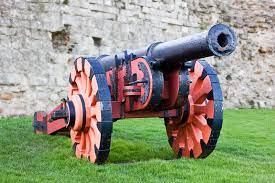Key Point: Demi-culverin is a type of early modern cannon used during the 17th century, typically characterized by its moderate size and ability to fire projectiles of varying weights.
In this installment of cannons throughout history we are taking a look at the Demi-culverin. What is this weirdly named cannon? How powerful was the Demi-culverin and what ultimately led to its downfall?
So obviously let’s start things off with a short introduction on its origin.
Origin Of Demi-Culverin
The Demi-culverin, as its name suggests, traces its roots back to the 16th century.
It emerged during a time of significant advancements in artillery technology, driven by the need for more powerful cannons on the battlefield. The term “culverin” itself referred to a type of cannon, and the prefix “demi” indicated that the Demi-culverin was a smaller variant of the original.
Initially, cannons were primarily cast from iron due to their durability and strength. But, advancements in metallurgy allowed for the use of bronze, which provided certain advantages such as improved accuracy and resistance to corrosion.
This transition to bronze, along with the demand for lighter and more maneuverable artillery, influenced the development of the Demi-culverin.
When it came to the design …

The design of the Demi-culverin drew inspiration from its predecessors, incorporating the lessons learned from earlier cannons such as the “Serpentine” and the larger “Culverin.”
As military commanders recognized the importance of artillery in warfare, the demand for cannons with greater range and power grew. The Demi-culverin filled a vital role on the battlefield, providing a balance between firepower and maneuverability. Its size and weight made it suitable for field operations, while its caliber and projectile capabilities made it effective against fortifications and infantry formations.
Physical Characteristics Of The Demi-Culverin
The Demi-culverin was a formidable cannon known for its distinct physical characteristics. It was approximately 9 feet long and weighed around 3,500 pounds. Crafted from iron or bronze, its sturdy construction allowed for reliable and accurate firepower on the battlefield.
And the projectiles it fired …?
Projectiles It Fired
The Demi-culverin fired various types of caliber projectiles, depending on the specific needs of the engagement. These projectiles included solid iron balls, chain shots, and even explosive shells. So, the versatility of the Demi-culverin’s ammunition allowed it to effectively engage both infantry formations and fortifications.
Utilization Of The Demi-Culverin In Battles
The Demi-culverin played a prominent role in several famous battles, leaving a lasting impact on the course of events.
A notable engagement was the Battle of Breitenfeld in 1631 during the Thirty Years’ War. The Swedish army, equipped with Demi-culverins, employed them to devastating effect against the formations of the Holy Roman Empire. The artillery’s superior range and destructive power contributed significantly to the Swedish victory, thus altering the balance of power in Europe.
But despite its effectiveness, Demi-culverin had some notable disadvantages that influenced its decline over time. Let’s examine those for a bit …
Disadvantages Of Demi-Culverin
Firstly, its size and weight made it challenging to maneuver on the battlefield, limiting its mobility and flexibility. And, the Demi-culverin did require a substantial crew to operate effectively, further impeding its deployment and logistical considerations.
These factors, combined with the emergence of more advanced artillery systems, gradually rendered the Demi-culverin obsolete on the battlefield.
And what type of cannon replaced it?
Successors To The Demi-Culverin
So, following the decline of the Demi-culverin, advancements in artillery technology led to the emergence of more powerful and efficient cannons. One such successor was the “Saker” cannon, which boasted improved range, accuracy, and mobility. The Saker became widely used in subsequent conflicts and became a prominent artillery piece in many European armies.
In Conclusion
Thank you very much for taking the time to read this article. I hope you learned a thing or two. And I will see you at the next one. If you wish to continue learning about cannons from history I suggest you take a look t this article on the Falcon cannon, right here.
Take care!
Sources:
“Tudor Artillery, 1485-1603 Early Cannons & Artillery” by Adrian B. Caruana